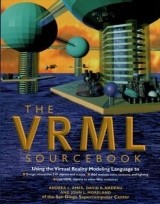
The VRML Sourcebook
John Wiley & Sons Inc (Verlag)
978-0-471-14159-4 (ISBN)
- Titel ist leider vergriffen;
keine Neuauflage - Artikel merken
The best book available on VRML from the only people who could have written it This team of experts from the SDSC (San Diego Supercomputer Center) have written the most authoritative and comprehensive guide available for creating 3-D virtual worlds on the Internet with VRML. Focusing on step-by-step guidance and insider tips and tricks, this task-oriented guide contains everything you need to make optimum use of this new technology. The VRML Sourcebook explains: How to design complex objects for your virtual world using VRML How to use special lighting, camera angles, and professional graphics techniques to create extremely realistic worlds that people will want to explore Packed with fascinating and instructive examples, diagrams, and screen captures, The VRML Sourcebook is an invaluable technical resource for professional developers and hobbyists alike. Visit our Web page and ftp site (see inside for details), where you'll find: All the sample VRML worlds described in this book Links to other sites where you can download VRML browsers and tools
ANDREA L. AMES is a technical communication expert who works at the SDSC, where she designs, writes, and edits information for online interactive multimedia, WWW, print, and other media. DAVID R. NADEAU is an expert in interactive 3-D graphics, and is co-leader of the VRML research and development effort at the SDSC. JOHN L. MORELAND is an expert in multimedia systems and programming for interactive multimedia and is part of the VRML R&D team at the SDSC.
Understanding Key VRML Concepts. Using Predefined Shapes. Using Text. Positioning Shapes. Rotating Shapes. Scaling Shapes. Translating, Rotating, and Scaling Shapes. Performing Custom Shape Transforms (Advanced). Shading with Materials. Grouping Nodes. Instancing Shapes. Linking in Your Worlds. Creating Shapes with Faces, Lines, and Points. Building Materials to Shapes. Advanced Shading Techniques. Optimizing How VRML Draws Faces (Advanced). Mapping Textures. Lighting Your Worlds (Advanced). Shading Shapes with Advanced Materials. Controlling Detail (Advanced). Using Cameras. Providing Information About Your Worlds. Appendices. Index.
| Erscheint lt. Verlag | 1.12.1996 |
|---|---|
| Zusatzinfo | Illustrations (some col.) |
| Verlagsort | New York |
| Sprache | englisch |
| Maße | 187 x 232 mm |
| Gewicht | 1106 g |
| Themenwelt | Mathematik / Informatik ► Informatik ► Grafik / Design |
| Mathematik / Informatik ► Informatik ► Netzwerke | |
| Mathematik / Informatik ► Informatik ► Theorie / Studium | |
| Mathematik / Informatik ► Informatik ► Web / Internet | |
| ISBN-10 | 0-471-14159-3 / 0471141593 |
| ISBN-13 | 978-0-471-14159-4 / 9780471141594 |
| Zustand | Neuware |
| Haben Sie eine Frage zum Produkt? |
aus dem Bereich



